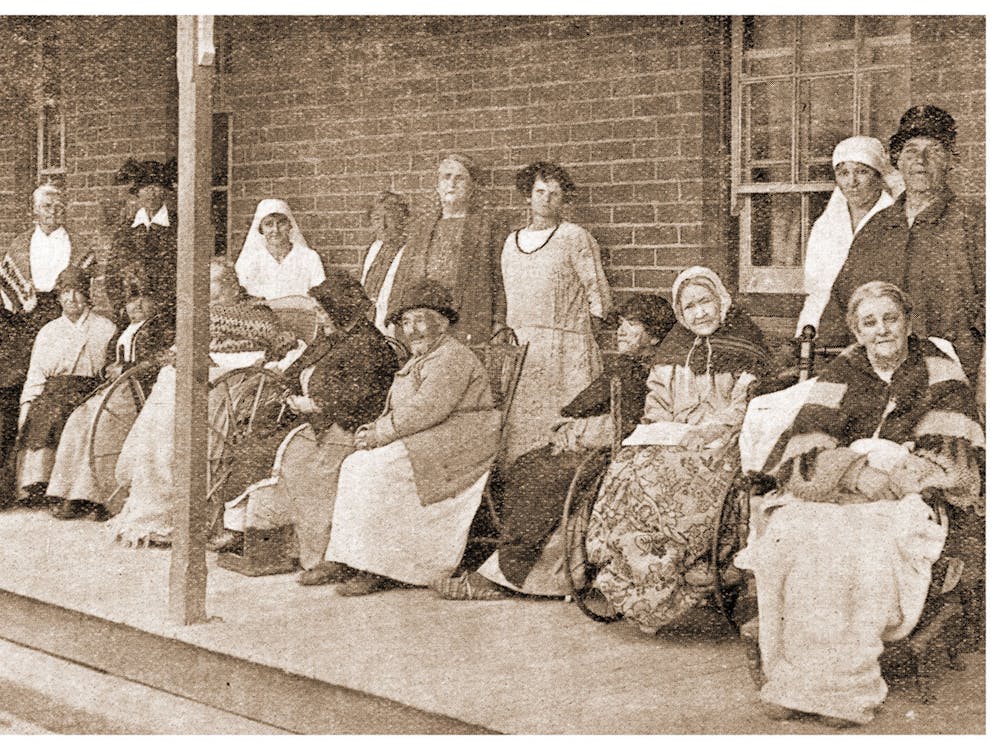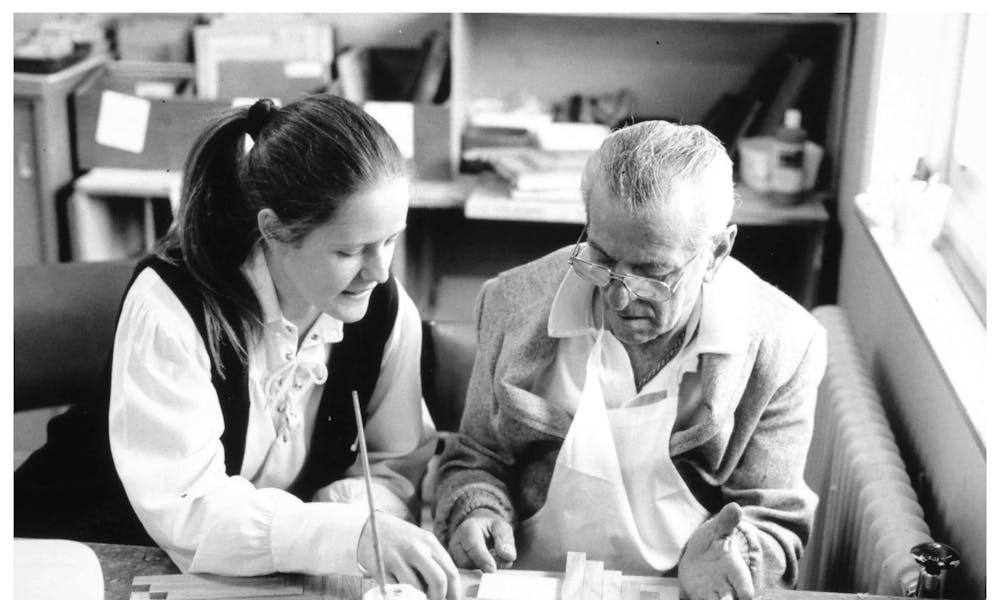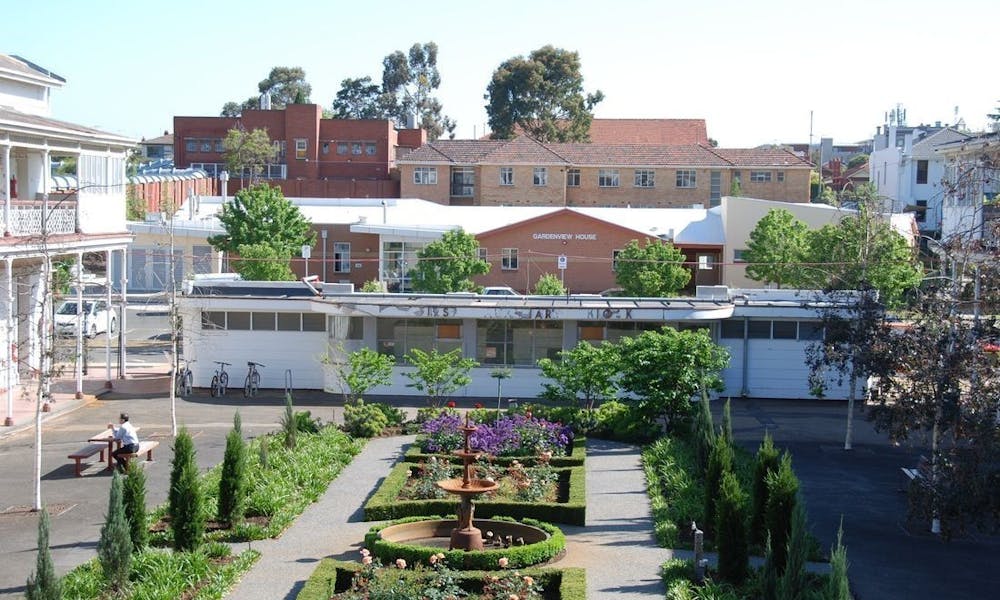Learn more about the history of the Royal Melbourne Hospital's Royal Park campus.
Key points
- The origins of our Royal Park site can be traced back to the 1850s gold rush
- Its origins are linked to both St Kilda Road and also Royal Park
- There have been several name changes throughout its history, including Mount Royal Special Hospital for the Aged and North West Hospital
- It became known as the Royal Melbourne Hospital Royal Park Campus in 2005

The origins of the Royal Melbourne Hospital (RMH) Royal Park can be traced back to the gold rush of the early 1850s. The discovery of gold brought immigrants from all parts of the world in their thousands to Victoria.
Many arrived in Melbourne with little or no money and no means to support themselves in their search for gold. From this situation, The Immigrants’ Aid Society was formed in 1853, and in the 1880s it was the foremost charitable institution in Melbourne.
The history of our Royal Park Campus covers shifts in caring for immigrants, to the poor and destitute, the elderly, infirm and those needing rehabilitation. Being at the forefront of changing societal attitudes and policies in health and welfare services is a constant theme throughout this journey.
Despite numerous name changes throughout its history, the focus of the institution has always been on the welfare of the patients and residents in its care and today, the site offers extensive innovative, high-quality aged care and rehabilitation services.

1853 to 1914: St Kilda Road
Melbourne was a small provincial town in 1851 with a population of 23,000, but by 1853 it was the largest city in Australasia with more than 70,000 people.
Immigrants arrived with little or no money, not realising a trip to the goldfields involved an eight-day journey with provisions that had to be paid for at exorbitant prices.
So, many stayed on in Melbourne, and accommodation and provisions became both scarce and expensive as a result of this vast influx of people. A tent city, known as Canvas Town, sprang up to house these numbers on the outskirts of Melbourne, on the track that was St Kilda Road.
Tents were pitched for a weekly rent of five shillings. Those who could not afford this rent lived in the open or sought shelter among the trees.
Public sympathy for newly arrived, impoverished immigrants was aroused by The Argus newspaper reports in April 1853. Many prominent citizens convened a meeting in the Town Hall on 9 May and set up a provisional committee to enquire into conditions for immigrants.
The report of the provisional committee was read to a public meeting on 17 May 1853 at the Mechanics’ Institute on Collins Street (later the Athenaeum), leading to the formation of The Immigrants’ Aid Society for "the amelioration of the fearful distress" of the new arrivals.
The report suggested that information should be provided to immigrants on arrival: verbally by an agent on the wharf and in written ‘tracts’ published by the Society.
Temporary buildings were to be erected to provide free lodgings, luggage would be stored and loans or grants of money arranged. Assistance was to be given in securing employment, and medical advice and medicines were to be made available.
An office was set up on the corner of Swanston and Collins Streets, on land then known as the Town Hall Reserve, and a store for luggage was established on the corner of King and Flinders Streets, near the wharf. A fever tent and dispensary were set up adjacent to Canvas Town and temporary accommodation was found for immigrants.
By October 1853, 35 patients had been treated in a "sick ward" and medicines prescribed for a further 221 people. In 1854, wooden buildings on St Kilda Road became the first home established by the society.
The initial purpose of The Immigrants’ Aid Society was to provide aid only to new arrivals, until they were able to provide for themselves. It waived the rule that limited assistance to those having less than two years residence in Victoria by 1861.
The work of the society increased, and in 1862 a Hospital for Chronic Diseases was established as part of the Immigrants’ Home. Later, the society also incorporated a blind asylum and a night refuge for those requiring overnight accommodation on a casual basis.
Increasingly, the hospital’s wards were occupied by patients with incurable illnesses and convalescing patients transferred from other hospitals.
In 1866, a government grant of £400 enabled the society to replace its old and dilapidated dwellings with more substantial buildings on both sides of St Kilda Road. In 1870, the institution changed its name to the Immigrants’ Aid Society’s Home for Houseless and Destitute Persons.
Additional buildings included a laundry, hospital, further dormitories and a mess hall by 1871. The male inmates were transferred to an empty industrial school site at Royal Park in 1882.
By the early 20th century, the Immigrants’ Aid Society had substantially altered and expanded the welfare services it was providing the citizens of Victoria. By then it had little connection with immigrants and had become a benevolent asylum for the poor, elderly and convalescent transferred from other hospitals.
To reflect this change in function, the society altered its name to Victorian Homes for the Aged and Infirm in 1902.
A property was purchased in 1914 at 64 Latrobe Street to act as a receiving depot, with accommodation for 50 people and additional space for an office and boardroom. Both casual occupants and patients awaiting operations at, or admissions to, other hospitals were accepted.
This depot was closed in 1943, and the building was demolished in 1954. The remaining operations, along with the female and child inmates, were transferred from St Kilda Road to Royal Park in 1914.


1840s to 1920s: Royal Park
Consideration was given to reserving land in Melbourne for recreational purposes as early as 1841. The Melbourne Corporation (later City Council) in January 1844 petitioned the Governor in Sydney to grant a reserve of 2560 acres north of the city of Melbourne for "the public advantage and recreation".
Debate and arguments followed regarding the ability of the financially troubled Melbourne Corporation to adequately maintain reserved parkland for public use. It was not until 1850 that this site was designated as part of a recreation reserve.
After the proclamation of the Colony of Victoria, portions of the reserve were sold in 1852 when the suburbs of Carlton and North Melbourne were formed. An area of 700 acres called Royal Park was "reserved for public uses within the Colony of Victoria" in May 1854.
An area of 142 acres was excised from the north-western corner of Royal Park in April 1858 for an "experimental farm" bounded by the Moonee Ponds Creek. The land was cleared of existing vegetation, subdivided into blocks, fenced and cultivated with various experimental cropping techniques.
The farm carried out research into the best methods of sowing, fertilising and reaping crops, including experiments with new crop varieties.
Despite the success of the Model Farm, the Government decided in 1860 that it must be self-supporting. Disputes arose and the farm manager resigned. The farm was subsequently closed down by the Government and was leased for farming to a tenant.
A portion of the Model Farm land was nominated by the Government in 1866 to be reserved for the site of a future industrial school to care for neglected and orphaned children. The first stage of the school, the Girls’ Division and staff and services wings, was built in 1875 and the buildings occupied.
There was a change in government policy in 1879, however, from institutional care to a system of "boarding-out" to foster parents. By May 1880 the girls at Royal Park were relocated to the Geelong Industrial School and boys were moved from Sunbury to Royal Park as an interim measure until boarding-out places could be arranged.
The boys had been removed and the Royal Park Industrial School buildings were left vacant by 1881. The site and buildings were given to the Immigrants’ Aid Society by the government in July 1882 for use as a home for houseless and destitute persons. At this time, the Male Division of the Society was relocated from St Kilda Road to Royal Park.
In 1914, the remaining operations, including female and child inmates, were transferred from St Kilda Road to Royal Park.
The change in name of the Society to Victorian Homes for Aged and Infirm in 1902 was followed by another in 1925 to the Victorian Benevolent Home and Hospital for the Aged and Infirm. By this time the majority of inmates no longer represented a range of ages, but were primarily elderly. This constituted the true start of geriatric care for the institution.

1930s to 1940s: From home to hospital
Extensive building works were undertaken throughout the 1930s and 1940s to meet the changing function of the institution from a home to a hospital. Extensive landscape works, which included a vegetable garden, were completed.
In addition to maintenance work and improvements to existing buildings, a single storey nurses’ home, a kiosk and a hospital ward for 108 male patients were constructed. These were followed by the Women’s Division, the Returned Soldiers Block, the Tuberculosis Building, known as the Dunstan Chalet, an additional storey to the existing Nurses’ Home and a new, adjacent nurses’ home.
In the 10 years to 1937 the number of infirmary beds grew from 90 to 300, outstripping the number of benevolent beds.
The transition from benevolent home to hospital was evident by the late 1930s as increasing numbers of long-term patients with chronic ailments were transferred to the institution from other hospitals. Another name change to Mount Royal occurred in 1939.
The following decade was marked by the development of geriatric welfare services and continual building works to meet these changing requirements. Further building works consisted of the Eleanor Shaw Chalet, modifications to the 1875 building, and further additions to the nursing accommodation.

1950s: Geriatric care and rehabilitation
A new approach to geriatric treatment was introduced in the 1950s with an emphasis on short-term accommodation for patients undergoing rehabilitation.
Services such as physiotherapy, occupational therapy and speech therapy were introduced to encourage more independence for the elderly, thus enabling them to return to independent living at home. The first specialist Geriatrician, Dr Graeme Larkins, was appointed in 1955.
There was also an extensive building program undertaken. Smaller units were constructed instead of the larger wards and some existing buildings demolished. A new kiosk on the northern end of the 1875 courtyard was built in 1950, and the Ambrose Pratt Memorial Chapel was constructed in 1955.
The Sir Herbert Olney Geriatric Unit - a new 76-bed purpose built rehabilitation, research and education unit - was completed in 1957. This was the first hospital unit in the southern hemisphere built specifically to provide geriatric rehabilitation. The clinical expertise at the unit completely changed ideas on the treatment and care of the elderly.
The institution became known as Mount Royal Special Hospital for the Aged in 1958. From this period the care of the aged remained the dominant focus, with new services associated with the research and education into the clinical, preventive, remedial and social aspects of illness in the elderly being introduced in the decades to come.

1960s to 1970s: Teaching and research
The care of the aged remained the dominant focus during the 1960s and 1970s with remedial treatments, initially introduced in the Geriatric Unit, being extended to all patients. Increasingly new services and facilities associated with the research and teaching of aged care were added.
These included:
- The opening of the Roy Ivey Day Hospital in 1962
- The Allied Health Services building in 1964
- The Brunswick Sheltered Workshop in 1968
- The transfer of ownership of the Henry Pride Wing at Kew from the Royal Women’s Hospital to Mount Royal in 1973
- The commencement of the Geriatric Community Care Service for the City of Brunswick, also in 1973
During this period Mount Royal became involved in the teaching of nurses, nurses aides, physiotherapists, social workers, occupational therapists and speech therapists. In addition, post-basic training of medical students was undertaken through the Victorian Postgraduate Geriatric Medical Training Program commenced in 1975.
The increase in specialist medical staff appointments in the mid-1970s recognised the broader concept of the needs of the aged and ageing. These appointments included a sessional ophthalmologist, cardiologist, neurosurgeon and a consultant in geriatric psychiatry.
Building works included the remodelling of older dormitory wards into smaller more modern units and the construction of new wards to provide nursing home beds. Additional areas to incorporate rehabilitation services such as physiotherapy and occupational therapy rooms, and dental and podiatry surgeries were constructed in 1964.
A new sterile supply area and further X-ray equipment were installed in 1970. With the increase in services came an increase in staff numbers, from 189 in 1957 to 452 in 1963. A childcare centre for staff was opened in 1974 in a house in Park Street, opposite the hospital. Care was provided for 27 children until the centre closed in 1988 due to financial difficulties.
Increasingly the concept of individual accommodation, rather than communal living, for the elderly was introduced. Princes Hill Village was opened in Carlton in 1961 and the Mount Royal Lodge Hostel in 1971.
With the construction of the hostel, and later the car park, the last traces of the Moonee Ponds Creek that had originally bisected the site were removed. By the end of this period accommodation was provided for 935 elderly people.
In 1975 the hospital, together with the University of Melbourne, established the National Research Institute of Gerontology and Geriatric Medicine to undertake research, not only on the care of the elderly but the social implication of old age. During this year the Denzil Don Medical Centre was also completed.
A name change to Mount Royal Hospital occurred in 1979.

1980s to 2000s: A new century
Mount Royal Hospital was recognised as a Special Clinical School by the Health Commission of Victoria in 1982, thereby enhancing the hospital’s medical teaching services. At this time further increases in specialist sessional medical staff occurred, namely a gastroenterologist, haematologist, dermatologist, neurologist and urologist.
Improvements to buildings during the 1980s included refurbishments to the administrative facilities, staff amenities, Chapel and the Hospital Education Centre. Modernisation of the National Research Institute of Gerontology and Geriatric Medicine’s facilities was also undertaken as well as the construction of the Robert Campbell Admission Wing in 1986.
The institution, after a merger with the Greenvale Centre, was renamed North West Hospital on 1 July 1991. The Greenvale Centre, originally known as the Broadmeadows Consumptive Sanatorium, was opened in 1905 to treat people with tuberculosis. Accommodation was for 35 patients in seven tents.
In the following 50 years, the need for such a service declined and the sanatorium grew and progressed in other directions.
The Greenvale Village for the Aged was inaugurated on 22 August 1955, with the first elderly patients being admitted that year. The sanatorium was officially closed in 1956, and in 1972 the village became known as Greenvale Geriatric Centre.
A new centre for rehabilitation, Sir William Upjohn House, was opened in 1974. The facilities at Greenvale were decommissioned in 1998 and services moved to a purpose-built facility, the Broadmeadows Health Service. This became part of the Northern Health grouping of health services in 2000.
Throughout the 1990s, the hospital shifted its geographic focus to the western and northern suburbs of Melbourne.
As a result, responsibility for both the Henry Pride Centre in Kew and the Hawthorn Day Hospital were transferred to the St. Georges and Inner East Geriatric Centre in 1991; the management of the Heidelberg Day Hospital was transferred to the Heidelberg Repatriation Hospital in 1992; and services at the Coburg Day Hospital were integrated into those offered at Parkville in 1994.
A name change for the joint hospital/university National Research Institute of Gerontology and Geriatric Medicine to NARI (National Ageing Research Institute) occurred in 1994. This institute is the first academic centre in Australia focused on research and ageing in Australia.
Through its published work, NARI has achieved international recognition in many fields of endeavour, supporting innovation and excellence in the care of the elderly.
The hospital became part of the Western Health Care Network in August 1995, and part of the North Western Health Care Network in October 1997. The rehabilitation program from the RMH’s Essendon campus moved to the North West Hospital’s Parkville site in 1998.
Today, the rehabilitation program assists people of all ages, not just the elderly. People with neurological diseases, in particular strokes, limb amputations, rheumatological conditions and chronic musculoskeletal pain all benefit from the program.
The institution was renamed Melbourne Extended Care and Rehabilitation Service on 15 July 1999, and became a part of Melbourne Health (now known as the Royal Melbourne Hospital) in July 2000. An $18 million capital redevelopment program commenced in 2000 with works including a new 40-bed rehabilitation inpatient unit and a 24-bed purpose-built complex care residential facility, named Gardenview.

2005 to today: A comprehensive range of care and services
On 24 January 2005, the Melbourne Extended Care and Rehabilitation Service became known as the Royal Melbourne Hospital Royal Park Campus.
The Royal Park Campus offers extensive innovative, high-quality aged care and rehabilitation services and is home to North Western BreastScreen.
Despite numerous name changes throughout its history, the focus of the institution has always been on the welfare of the patients and residents in its care.
Today, it provides a comprehensive and integrated range of ambulatory care and health services developed for the purposes of research, assessment, rehabilitation, treatment, support, education and care.

